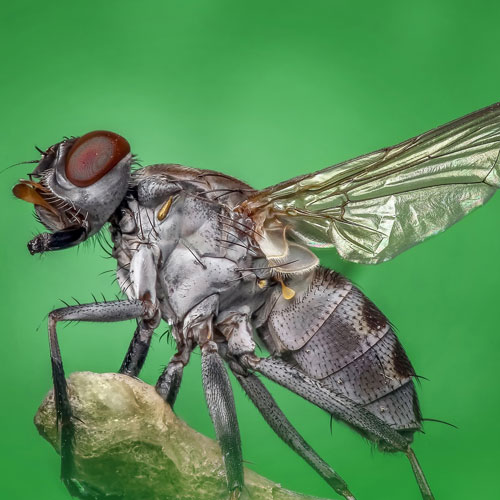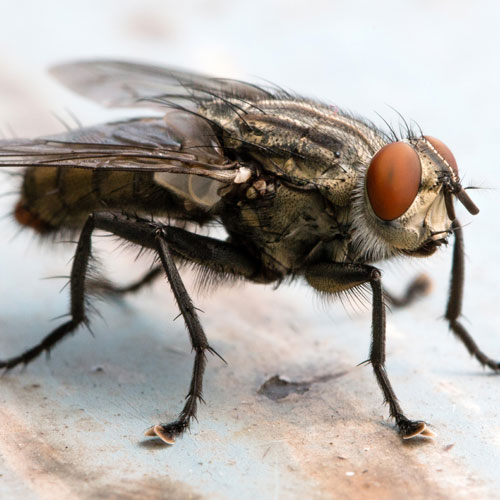Mud Dauber Nest Removal
Stinging and Flying Insects
Dirt – Mud Dauber
Dirt or mud dauber is a wasp that constructs it’s nest with mud. As the mud dries it becomes a hard dirt nest that is hard to dispose of. Dirt/mud daubers are about ½ – 1” in length and black in color. The body shape is long with a thin thread between the thorax and abdomen. Mud daubers are a beneficial insect due to their diet of spiders and other nuisance insects as well as honey dew and nectars. They are not likely to sting, but can. Use caution when removing nests if they appear to be active.

Yellow Jackets
Yellow jackets are sometimes mistakenly called “bees” because of their black and yellow coloring and the fact that they sting. They are actually in the wasp family. They have alternating bright yellow and black stripes and are almost shiny in appearance. They do not appear to have the hairy look of other bees. Typically yellow jackets build their nests in the ground or near the ground in a bush, hollowed tree or even a wall void of a structure. They can be behind shutters, in hollow fence posts, playground equipment, or other similar places. Yellow Jackets are aggressive and their sting is painful.

Paper Wasps
Paper wasps are a large flying, stinging insect that builds a nest that has a grey paper like appearance that is attached by a single string or strand with individual cells attached in clusters so that as the nest grows in size it looks a lot like an upside down umbrella. Paper wasps are about ¾” long and are dark brown or reddish in color with yellow markings. They are less aggressive, but will sting when provoked.

Hornets
Hornets are the largest of the stinging insects classified in the wasp family. They are extremely aggressive and their sting in very painful. They build nests in trees, on the sides of homes and other places they can attach them to. The nests are a papery substance that is built into a ball or cone shape, growing quickly from a small baseball size to as large as a basketball or bigger. They can also build nests in the ground. Nests population can reach more than 500 individuals by late summer. They fiercely guard the nests, so caution in advised.

Honey Bees
Honey bees while not protected in Missouri are a protected insect in Illinois and other states due to the decline in their populations. Honey bees are a social insect that has one queen per colony. They are the small, fuzzy, yellow and black bee that you often see in your yard area if you have clover or other flowering plants and trees. In their quest to find “food” for their nest (comb), they pollinate fruit trees and other flowering plants in order to make honey for their young. Survival of the species is their goal. It is our goal as well to protect these valuable insects. They are not aggressive, but the female honey bee can sting as a protective instinct. Drones (larger male honey bees) do not have a stinger and cannot sting.

Carpenter Bees
Carpenter bees are large black and yellow wood destroying bees. They appear aggressive due to their quest to protect their nest. Carpenter bees drill holes that are round about 3/8” of an inch in a perfect circle. The females are the only one with the stinger but they are normally working on the nest and the males are the ones buzzing around you. They cannot sting you but they normally scare the heck out of you. They are known for the damage they cause to wood and they prefer Cedar lumber because it’s softer. The real damage come in when the larva is inside the gallery of the wood and the wood peckers come and dig large holes trying to feed on the larva. Carpenter bees also leave yellowish stains on the siding materials right next to the holes.

House Flies
The most common fly is the house fly. You see them in a variety of places outdoor and indoors. Typically they will be hanging out where food and water are available, contaminating everything they touch. House flies easily carry disease from place to place as they light on food and surfaces. They lay their eggs in rotting or decaying material. While the life span of a fly can be as short as a few days up to as much as 60 days, they are a nuisance. Controlling them with a fly swatter is difficult due to their enhance vision. Wider control measures may need to take place. Be sure to keep all food and food prep areas clean and free of the smallest debris, especially spilled sugary drinks. When flies get the best of you, call STL Pest Control. We’ll be right there to help.

Cluster Flies
You may be used to swatting the occasional fly during the summer, but as fall approaches and the temps cool, you may see large numbers of flies on the sunny side of your home searching for a place to spend the winter. These flies breed in the soil during the warm months of the year and over winter in protected places nearby. Many times that winter home is your inside the walls of your home. On bright sunny days large numbers of flies can be seen on the exterior of your home or (worse) on your window sill looking for a place to get out. These flies are sluggish and easy to swat and kill, although the sheer number may have you running to call STL Pest Control. Home maintenance is the ultimate control of these nuisance insects. Caulk and seal small openings so that they can’t set up winter quarters at your home.

Fruit Flies
Small flying insects in the kitchen or bath may just be fruit flies. While these nuisance pests can be an issue year round, the abundance of fresh fruit and vegetables in the summer and early fall seem to be the time homeowners notice them. In restaurant and bar settings it’s a constant battle. Besides breeding in and around rotting or fermenting fruits and vegetables, (bananas, tomatoes, potatoes, etc) they will lay eggs in empty soda cans and bottles, garbage disposals, trash cans, drains, wet mops and other cleaning materials. It’s important to keep things clean and dry. Don’t leave a bucket of mop water or damp cleaning rags unattended. Empty the bucket and hang the rags to dry. Over watered house plants can also be a source. Once you eliminate the source of infestation, control can be achieved.

Fungus Gnats
Fungus gnats are sometimes confused as baby flies. They are insects that live on decaying plants and fungi. When they do appear they are normally in large quantities causing a big nuisance to you. To prevent this from having a large infestations is do not over water your plants. When they are over watered they will develop a fungi and the gnats will start feeding on that food source. Fungus gnats are generally not a problem in the outdoors due to all the natural predators that feed on them so they stay in check. They do play a major role by helping break up the dead vegetation and turning it into nutrients for other plants.

Mosquitos
We can offer mosquito reduction programs for your outdoor environment to help reduce the risk of exposure to mosquito populations on your property. We will help educate you on mosquito control in your own back yard that will help reduce breeding sites. Treatments for mosquitos can last 30 to 60 days. This may vary depending upon weather conditions, but normally treatments will last 60 days.
The CDC website can offer more detail on this growing virus transmitted by the Mosquito. Symptoms, diagnosis and treatment information can be found there. If you think you have been infected, see a doctor right away.
Learn more about the mosquito here.
Here are some of the things we know about this disease.
- Most people infected with Chikungunya virus will develop some symptoms.
- Symptoms usually show up 3–7 days after being bitten by an infected mosquito.
- The most common symptoms are fever and joint pain.
- Some of the symptoms may include headache, muscle pain and joint swelling that can cause joint muscle to contort.
- Most cases of Chikungunya disease do not result in death, but the symptoms can be painful and debilitating.
- Most patients feel better within a week. In some people, the joint pain may persist for several weeks or even months.
- There is no medicine to treat Chikungunya virus infection or disease.




Our Office


